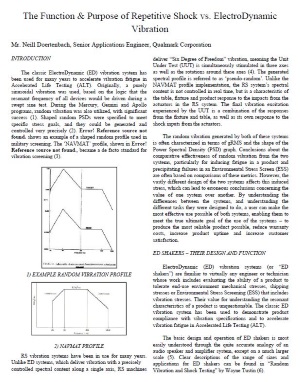
Mr. Neill Doertenbach, Senior Applications Engineer, of Qualmark Corporation originally prepared this research paper for the 2014 RAMS conference.
The classic ED vibration system has been used for many years to demonstrate product compliance with vibration specifications and to accelerate vibration fatigue in Accelerated Life Testing (ALT). Originally, a purely sinusoidal vibration was used, based on the logic that the resonant frequency of all devices would be driven during a swept sine test. During the Mercury, Gemini and Apollo programs, random vibration was also utilized, with significant success. However, there was some resistance to the idea of using random vibration to test other hardware. In 1971, Grumman Aerospace undertook a detailed study that conclusively showed the value of random vibration for detecting faults. In 1979, Willoughby created a random vibration spectral profile that was included in NAVMAT 9492. This ‘NAVMAT’ profile was nearly universally accepted as the best way to use random vibration as a screening tool.
RS vibration systems were first introduced in the late 1970’s. Unlike ED systems which deliver vibration with a precisely controlled spectral content along a single axis, RS machines deliver “Six Degree of Freedom” vibration, meaning the Unit Under Test (UUT) is simultaneously stimulated in three axes as well as the rotations around these axes. The generated spectral profile is referred to as ‘pseudo-random’. Unlike the NAVMAT profile implementation, the RS system’s spectral content is not controlled in real time, but is a characteristic of the table, fixture and product response to the impacts from the actuators in the RS system.
Unfortunately, the vast body of knowledge and experience associated with ED shakers has led many users to evaluate RS systems using the same metrics that work so well with ED shakers, resulting in confusion and misconceptions about the purpose, value and fatigue characteristics of the RS system. This paper describes the key differences between the function of RS and ED systems, with an emphasis on the difference in the UUT response and the fatigue experienced by the UUT. The different systems are shown to meet different, but equally important, goals in the design, evaluation and screening of electrical, electromechanical and purely mechanical systems. This includes an in-depth evaluation of the differences in the real time excitation to a UUT and the resultant fatigue. The paper then outlines the best applications for each type of vibration system to meet the goals of producing a reliable product that meets your customers’ expectations.
Advertisement
Learn more about Qualmark Corp.





